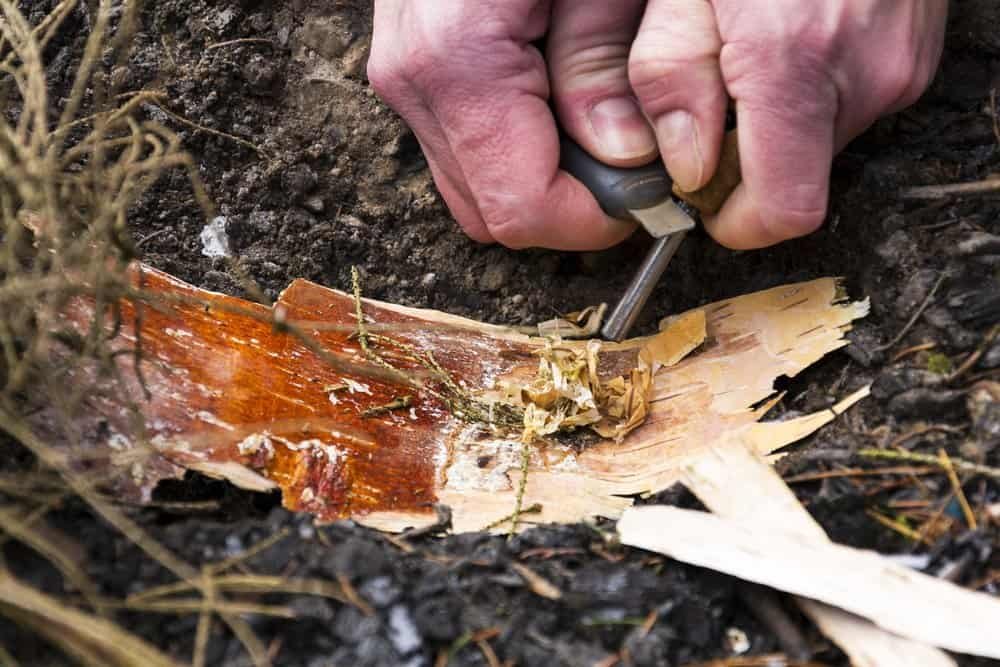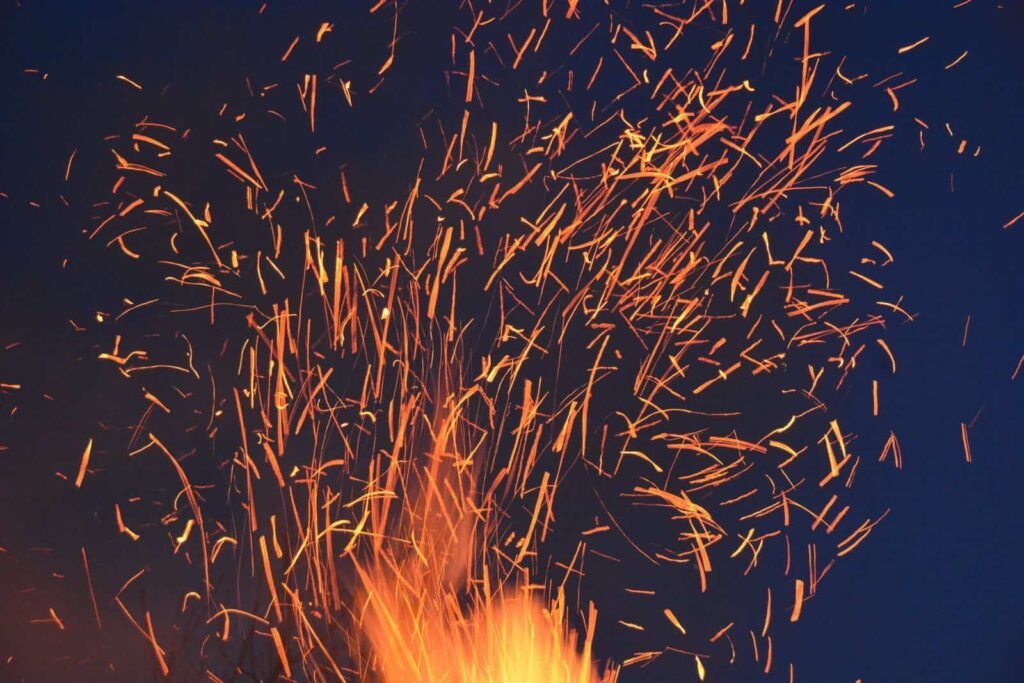When it comes to starting a fire in the outdoors, having the right tools can make all the difference. One of the most reliable tools you can carry is a ferro rod.
A ferro rod is a simple yet powerful tool that creates sparks when you scrape it with a hard object, like a knife. These sparks are incredibly hot, making it easy to light dry leaves, grass, or other tinder to get a fire going.
But not all tools are equally effective at striking a ferro rod. This brings us to an interesting question: Can a stainless steel knife spark a ferro rod? This article looks at whether a stainless steel knife can spark a ferro rod. It also offers helpful tips for starting a fire with these tools.
Understanding Ferro Rods
A ferro rod is a special tool used to start fires, and it’s a favorite among campers, hikers, and survivalists. The name “ferro rod” comes from the material it’s made of, called ferrocerium. This metal alloy is unique because when you scrape it with something hard, like a knife or a piece of metal, it creates very hot sparks. These sparks can reach temperatures of over 3,000 degrees Celsius, which is hot enough to light dry tinder and start a fire.
The way a ferro rod works is pretty simple. When you scrape the rod, small pieces of the ferrocerium are shaved off. The friction between the rod and the scraper causes these tiny pieces to ignite, turning into bright, hot sparks. These sparks can land on dry tinder, like leaves or grass, and help you start a fire quickly.
Ferro rods are very popular because they work in almost any weather condition. Whether it’s raining, snowing, or windy, a ferro rod can still produce sparks and help you start a fire. This makes them a reliable tool to have in your backpack whenever you’re outdoors.
Another great thing about a ferro rod is that it lasts a long time. Unlike matches or lighters, which can run out or be affected by the wind, a ferro rod can be used thousands of times before it wears out. This makes it a cost-effective and dependable tool for anyone who enjoys spending time in nature.

Properties of Stainless Steel Knives
Stainless steel knives are commonly used for outdoor activities because they are durable, resistant to rust, and easy to maintain. But how do these properties affect their ability to spark a ferro rod? Let’s explore the key characteristics of stainless steel knives and how they relate to using a ferro rod.
Rust Resistance
- Stainless steel is known for its resistance to rust and corrosion, which makes it a great choice for outdoor knives. This rust resistance is important because it means your knife will stay in good condition even if it gets wet or is exposed to the elements.
- However, the very property that makes stainless steel resistant to rust can also make it a bit less effective at striking a ferro rod. Rust resistance often means that the metal is less likely to create the strong friction needed to produce hot sparks.
Hardness
- Stainless steel is harder than many other metals, which means it holds its edge well and stays sharp for longer periods. This hardness is beneficial when you’re using the knife for cutting, slicing, and other tasks in the outdoors.
- When it comes to striking a ferro rod, the hardness of the stainless steel knife can help create sparks, but the knife’s edge might need to be sharp and at the right angle. Some types of stainless steel are harder than others, and harder steels can be better at producing sparks when used with a ferro rod.
Edge Retention
- Stainless steel knives are designed to keep their sharp edge over time, which is one of the reasons they’re so popular. A sharp knife edge can produce more consistent sparks when striking a ferro rod because it creates more friction.
- However, if the knife edge is too smooth or too polished, it might slide over the ferro rod without creating enough friction to generate sparks. This means that while edge retention is good for regular knife use, it might require a slightly rougher edge to work well with a ferro rod.
Blade Thickness:
- The thickness of a stainless steel knife blade also plays a role in its effectiveness with a ferro rod. A thicker blade might be more durable for heavy-duty tasks, but it could be harder to create the right amount of friction needed to produce sparks.
- A thinner blade, on the other hand, might make better contact with the ferro rod, leading to more effective spark production. The type of edge you use on the knife—whether it’s the spine (the back of the knife) or the sharpened edge—can also impact how well it works with the ferro rod.
Can Stainless Steel Spark a Ferro Rod?
The big question is whether a stainless steel knife can actually spark a ferro rod effectively. The answer is yes, a stainless steel knife can spark a ferro rod, but there are a few important factors that can affect how well it works. Let’s break down these factors:
Type of Stainless Steel
- Not all stainless steel is the same. There are many different types of stainless steel, and some are better at striking a ferro rod than others. For example, knives made from high-carbon stainless steel tend to create better sparks because they have a harder edge. This hardness helps create the necessary friction when scraping against the ferro rod.
- On the other hand, softer types of stainless steel might not be as effective because they don’t create as much friction. They might still produce sparks, but they could be weaker or less consistent.
Knife Edge Sharpness
- The sharpness of the knife’s edge is another crucial factor. A sharp knife edge can bite into the ferro rod and shave off small particles of metal, creating hot sparks. If your stainless steel knife is dull, it might slide over the ferro rod without creating much friction, leading to fewer or weaker sparks.
- However, sometimes the spine of the knife (the back edge) is used to strike the ferro rod instead of the sharp blade. If the spine has a 90-degree angle and is not too rounded, it can also work well for sparking a ferro rod. This technique helps preserve the sharpness of the knife blade for other tasks.
Angle of Striking
- The angle at which you strike the ferro rod with the stainless steel knife is very important. Holding the knife at the right angle can maximize the contact between the rod and the knife, creating more friction and therefore more sparks. Usually, a 45-degree angle is effective for striking a ferro rod.
- If the angle is too shallow, the knife might just skim over the surface of the ferro rod without creating enough friction to produce sparks. If the angle is too steep, it might gouge the ferro rod too much, wearing it down quickly without producing many sparks.
Pressue Applied
- The amount of pressure you apply when scraping the ferro rod also plays a role. Applying firm, controlled pressure helps to shave off the right amount of material from the ferro rod, leading to strong sparks. Too little pressure might not produce enough sparks, while too much pressure can wear down the ferro rod too quickly or even damage your knife.
- Practicing the right technique is key. By experimenting with different amounts of pressure, you can find the sweet spot that produces the best sparks without damaging either your knife or the ferro rod.

Tips for Using a Stainless Steel Knife with a Ferro Rod
Using a stainless steel knife to spark a ferro rod can be very effective if you know the right techniques. Here are some helpful tips to make sure you get the best results when using these tools together:
Use the Spine of the Knife
- One of the best ways to strike a ferro rod with a stainless steel knife is by using the spine, or back, of the knife instead of the sharp edge. The spine is usually at a 90-degree angle, which can create a good amount of friction when scraped against the ferro rod.
- Using the spine has another benefit: it keeps the blade sharp for cutting tasks. This way, you won’t dull your knife’s edge by repeatedly scraping it against the ferro rod.
Hold the Knife at the Right Angle
- The angle at which you hold the knife when striking the ferro rod is crucial. A 45-degree angle is often the best for generating strong sparks. This angle allows the knife to make good contact with the ferro rod, creating enough friction to shave off small particles that ignite.
- If you’re not getting enough sparks, try adjusting the angle slightly. Practice will help you find the angle that works best with your specific knife and ferro rod combination.
Apply Firm, Controlled Pressure
- When striking the ferro rod, you need to apply firm, controlled pressure. This helps ensure that you shave off just enough material from the ferro rod to create hot sparks without wearing it down too quickly.
- Too little pressure might not produce enough sparks, while too much pressure could damage both the knife and the ferro rod. Start with moderate pressure and adjust as needed to find the right balance.
Keep the Knife and Ferro Rod Close to the Tinder
- To increase your chances of starting a fire quickly, hold the knife and ferro rod close to the tinder. This allows the sparks to land directly on the tinder, giving it the best chance to catch fire.
- Make sure your tinder is dry and well-prepared. Using small, fine tinder will help the sparks ignite it more easily.
Practice Your Technique
- Like any skill, using a stainless steel knife with a ferro rod takes practice. Spend some time practicing your technique in a safe, controlled environment, like a backyard or a designated camping area.
- The more you practice, the more confident you’ll become in your ability to start a fire quickly and efficiently, even in challenging conditions.
Maintain Your Knife
- After using your knife to strike a ferro rod, it’s important to maintain it properly. Clean the spine or edge you used to remove any residue, and check the knife for any signs of wear.
- Regularly sharpening your knife will keep it in good condition for both cutting and fire-starting tasks. A well-maintained knife is safer and more effective.
Alternatives to Stainless Steel Knives
While a stainless steel knife can be used to strike a ferro rod, there are other tools and materials that might work even better. These alternatives are often preferred by outdoor enthusiasts and survivalists because they can produce stronger sparks or are easier to use with a ferro rod. Let’s explore some of these options:
Carbon Steel Knives
- Carbon steel knives are a popular choice for striking a ferro rod. Unlike stainless steel, carbon steel is typically harder and can produce more intense sparks. This hardness allows the knife to shave off more material from the ferro rod, leading to a bigger shower of sparks.
- Another advantage of carbon steel knives is that they often have a rougher edge, which can create better friction against the ferro rod. However, it’s important to note that carbon steel can rust more easily than stainless steel, so these knives require regular maintenance to keep them in good condition.
Dedicated Ferro Rod Strikers
- Some ferro rods come with dedicated strikers, which are small metal pieces specifically designed to create sparks. These strikers are usually made from materials that are excellent at generating friction with the ferro rod, such as high-carbon steel.
- Dedicated strikers are often easier to use than knives because they’re designed specifically for this purpose. They’re also lightweight and compact, making them a convenient addition to your fire-starting kit. Plus, using a dedicated striker means you don’t risk dulling your knife’s edge.
Flint and Stone
- Another traditional alternative is using flint or other types of hard stone to strike the ferro rod. Flint has been used for centuries to create sparks and start fires. When you strike flint against a ferro rod, the hard surface of the stone shaves off bits of metal, producing sparks.
- The key to using flint or stone effectively is to ensure it has a sharp edge. This sharp edge can create enough friction with the ferro rod to generate sparks. While this method might require more practice to master, it’s a great way to start a fire using natural materials.
Metal Files or Saw Blades
- Metal files or saw blades, especially those made from high-carbon steel, can also be used to strike a ferro rod. These tools have rough, serrated edges that can scrape off plenty of material from the ferro rod, creating strong sparks.
- Using a metal file or saw blade as a striker can be a good option if you’re looking for something that’s tough and easy to handle. However, these tools are bulkier than a knife or a dedicated striker, so they might not be as convenient to carry on outdoor trips.
Multi-Tools with Built-In Strikers
- Some multi-tools come equipped with built-in ferro rod strikers. These strikers are often small, but they’re designed to be highly effective at producing sparks. Multi-tools are great because they combine several useful tools in one compact package, making them versatile for various tasks, including fire-starting.
- If you already carry a multi-tool, using the built-in striker can save space and reduce the number of items you need to carry. Just make sure the striker is accessible and easy to use in an emergency.
FAQ
Q1: Can any stainless steel knife spark a ferro rod?
A: Most can, but effectiveness depends on the type of stainless steel and sharpness.
Q2: Should I use the blade or the spine of the knife?
A: Use the spine to preserve the blade’s sharpness and create better sparks.
Q3: Why isn’t my knife sparking?
A: The edge might be too smooth, or you may need to adjust the angle or pressure.
Q4: Will using a ferro rod damage my knife?
A: It might cause minor wear, especially on the blade. Use the spine to minimize damage.
Q5: Are some stainless steels better for sparking?
A: Yes, high-carbon stainless steels like 440C or VG-10 work better.
Q6: Is a dedicated striker better?
A: Yes, dedicated strikers are designed to produce stronger sparks.
Conclusion
While a stainless steel knife can spark a ferro rod, its effectiveness depends on factors like the type of steel, the knife’s edge, and your technique. By using the spine of the knife and practicing the right angle and pressure, you can improve your fire-starting skills. However, having a dedicated striker as part of your kit can make the process easier and more reliable. Whether you rely on your stainless steel knife or a dedicated striker, understanding these tools and how to use them effectively will help you stay prepared in any outdoor situation.

